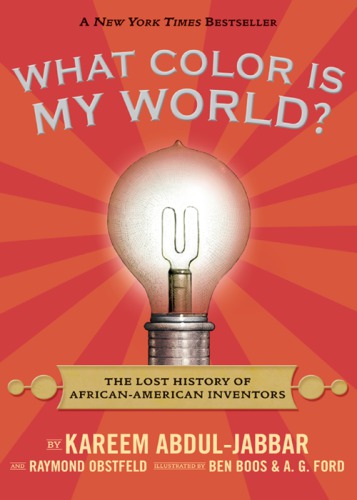
What Color Is My World?
The Lost History of African-American Inventors
فرمت کتاب
ebook
تاریخ انتشار
2012
Lexile Score
880
Reading Level
4-5
ATOS
6.1
Interest Level
4-8(MG)
نویسنده
Ben Boosناشر
Candlewick Pressشابک
9780763664411
کتاب های مرتبط
- اطلاعات
- نقد و بررسی
- دیدگاه کاربران
نقد و بررسی

ikyra_marie - This is a really cool book actually by the famous basketball player,Kareem Abdul-Jabbar.Anyone who likes to learn about or wants to be an inventor should read this book.It has a lot of information about African American inventors who contributed greatly to out society today.

November 28, 2011
Making use of an unusual format, former NBA star Abdul-Jabbar and his On the Shoulders of Giants coauthor Obstfeld offer an upbeat history lesson set within a fictional narrative framework. Siblings the Shoulders of Giants coauthor Obstfeld offer an upbeat history lesson set within a fictional narrative framework. Siblings Ella and Herbie, whose story unfolds in typeset chapter booklike pages surrounded by warmly lit paintings of their adventures, are less than enthusiastic about their fixer-upper of a new house. But as eccentric handyman Mr. Mital unveils the house’s potential, he also teaches them about contributions made by African-American inventors (“There’s more to our history than slavery, jazz, sports, and civil rights marches,” he says). Flaps show lifelike portraits of individuals like Dr. Mark Dean, a v-p at IBM; Dr. Charles Drew, who developed the concept of blood banks; and nuclear engineer Lonnie Johnson, inventor of the Super Soaker squirt gun. Ella’s off-the-cuff notes appear inside the flaps, while several spreads provide detailed profiles of other inventors and graphic novel–style passages. The banter between the siblings and, in particular, Ella’s snarky zingers keep things from feeling didactic—it’s an entertaining and often surprising exploration of lesser-known innovators, past and present. Ages 8–12. Agent: Iconomy.

February 1, 2012
Gr 4-7-A fictional story lies at the heart of this unusually formatted collective biography. Twins Herbie and Ella and their parents have just moved into a run-down older home; while they work to fix it up, Mr. R. E. Mital, an eccentric handyman hired by their parents, recounts the contributions of African American scientists and inventors. As the figures are introduced, foldouts on the sides of the pages contain Ella's notes (full of humor, as well as facts) about each one. More detailed profiles of other inventors fill the spreads, and some are introduced in graphic-novel-style pages. Instead of famous inventors such as George Washington Carver and Benjamin Banneker, readers are introduced to lesser-known individuals, including Alfred L. Cralle (inventor of the ice-cream scoop), Dr. Henry T. Sampson (gamma electric cell), and nuclear engineer Lonnie Johnson (Super Soaker). Information about the subjects' home, lives, and avocations is a welcome addition. The lack of an index and table of contents limits the book's usefulness for research; however, the large trim size, numerous illustrations, and unusual format (not to mention the celebrity author) will certainly attract browsers. And a surprise discovery about Mr. Mital's identity at the end will leave readers with something to ponder.-Jackie Partch, Multnomah County Library, Portland, OR
Copyright 2012 School Library Journal, LLC Used with permission.

January 1, 2012
A handyman named R.E. Mital teaches a pair of twins about great African-American inventors and scientists as they explore their new house. The authors interweave the story of the brother and sister and their unusual house guide with facts about men and one woman whose achievements have become part of our everyday lives. Each room they explore provides Mr. Mital with an opportunity for a biographical presentation. Thus, turning on a light bulb opens a discussion about Lewis Latimer, while cleaning the bathroom cabinet leads to information about Drs. Percy Julian, Daniel Hale Williams and Charles Drew. Time in the kitchen segues into facts about George Crum and the potato chip. A cell phone leads to details about Dr. Mark Dean and computer graphics, Dr. Valerie L. Thomas and 3-D and James West and microphones. Information is set apart from the narrative of the squabbling siblings through the use of page flaps, page backgrounds of varying colors, the boy's hand-written notes and occasional graphic presentations. Each biographical entry, through brief, pays equal attention to the discrimination that the innovators faced. Unfortunately, the lack of an index and a table of contents make this problematic for homework assignments A purposeful but appealing presentation of information about accomplished lives. And the guide? Examine his name. (authors' notes, bibliography) (Informational fiction. 8-12)
(COPYRIGHT (2012) KIRKUS REVIEWS/NIELSEN BUSINESS MEDIA, INC. ALL RIGHTS RESERVED.)

February 1, 2012
Grades 3-6 In his first foray into writing for children, basketball superstar Abdul-Jabbar teams with Obstfeld to introduce 16 mostly lesser-known African American inventors through a fictional story told by young twins, who learn that many items in a typical house and used by a majority of Americans were invented or developed by African Americans. These include the lightbulb, the ice cream scooper, the microphones in cell phones, and even fun stuff like the Super Soaker. Most of the inventors receive a spread complete with a flap with some fast facts that opens to a more in-depth paragraph, while others receive a larger narrative in cartoon form, followed by a two-page biography. Told in the voices of the fictional characters, the tone is informal and chatty. This, combined with the large coffee-table-style format, and the lack of an index, makes the book more for browsing than for research. A list of additional texts, videos, and websites is provided.(Reprinted with permission of Booklist, copyright 2012, American Library Association.)

























دیدگاه کاربران